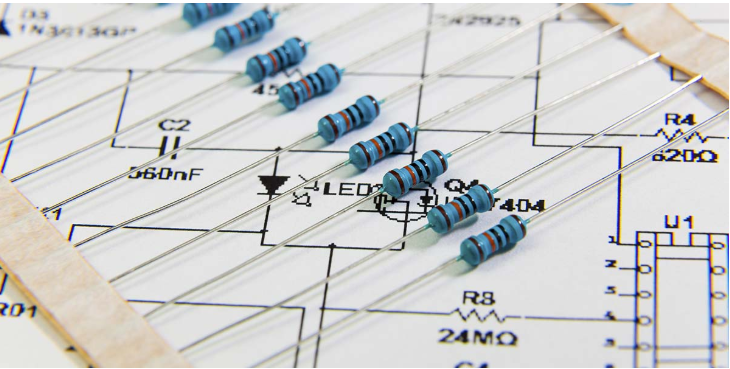Position:Home » Industry News
Resistors' Role for LEDs
Writer:Microhm Page View:Date:2019-12-30
LEDs are constant current devices with a predictable forward voltage drop based on the amount of current flowing through them. These current-voltage (I-V) curves are available in the datasheet for specific LEDs. If you want to drive a green LED with a forward voltage of 3V off a 5V power supply, you need something in that circuit to absorb the extra 2V. If you do not absorb that extra voltage, the LED junction will try to draw enough current to increase that voltage to 5V and burn itself up. The easiest way to absorb extra power in a circuit is to use a simple resistor, such as PMRY, MPR series and more. You need to know the intended LED to define the resistor using V=IR, but the math is very straightforward once you determine your system parameters. If you want to drive that 3V LED at 10mA, you need to absorb 2V at 10mA in a resistor. 2V = 10mA * R. Solving for R gives a resistor value of 200ohms, a common value that you likely already have in a kit somewhere.

This method is perfectly fine for a power-good indicator LED or any situation where a single low power LED is used. If you do this with LEDs in parallel, the trials begin. LEDs and resistors have their values given within a range, not as absolutes. The cheap, common value resistors you would likely use in a design are typically +/-10%, meaning a 100 ohm resistor could really be any value between 90 ohms and 110 ohms. The forward voltage of a given LED is also a range. LEDs are sorted into groups called “bins” based on their specific color and voltage measurements after production. Depending on how tightly binned you get your LEDs (tighter binning is more expensive), you could see as much as half a volt difference from one LED to the next.

None of these variances are enough to cause trouble in a single-LED situation. If there is nothing to compare to, our eyes will not notice that an extra few milliamps are flowing through a lone indication LED. However, our eyes will absolutely notice brightness variations in a fixture with several LEDs or strands of LEDs running in parallel. Get a string of lower-voltage LEDs next to one with higher voltages and you will definitely see a difference. It is not impossible to get highly precise resistors and mate the correct resistor to each individual strand of LEDs, but this is not practical on any sort of scale and will be both expensive and time consuming. Microhm Electronics PMRY series is an ideal solution.
This is where designers turn to current regulating devices. When multiple strands must be run in parallel due to voltage constraints, the best solution is often to place a small constant current device in series with each string to ensure all strands are performing equally. These devices can be as small as a power resistor and cheaper than high-precision resistors.

This method is perfectly fine for a power-good indicator LED or any situation where a single low power LED is used. If you do this with LEDs in parallel, the trials begin. LEDs and resistors have their values given within a range, not as absolutes. The cheap, common value resistors you would likely use in a design are typically +/-10%, meaning a 100 ohm resistor could really be any value between 90 ohms and 110 ohms. The forward voltage of a given LED is also a range. LEDs are sorted into groups called “bins” based on their specific color and voltage measurements after production. Depending on how tightly binned you get your LEDs (tighter binning is more expensive), you could see as much as half a volt difference from one LED to the next.

None of these variances are enough to cause trouble in a single-LED situation. If there is nothing to compare to, our eyes will not notice that an extra few milliamps are flowing through a lone indication LED. However, our eyes will absolutely notice brightness variations in a fixture with several LEDs or strands of LEDs running in parallel. Get a string of lower-voltage LEDs next to one with higher voltages and you will definitely see a difference. It is not impossible to get highly precise resistors and mate the correct resistor to each individual strand of LEDs, but this is not practical on any sort of scale and will be both expensive and time consuming. Microhm Electronics PMRY series is an ideal solution.
This is where designers turn to current regulating devices. When multiple strands must be run in parallel due to voltage constraints, the best solution is often to place a small constant current device in series with each string to ensure all strands are performing equally. These devices can be as small as a power resistor and cheaper than high-precision resistors.
Keywords:
Latest News
- Resistor's role in measuring and correcting LED,,,
- Single through-hole resistors' characteristics ,,,
- Why shunt resistors for current sense applicati,,,
- Metal-film resistors with small size, high resi,,,
- 36W High-Current Shunt Resistors MMS8420,,,
- 1W Surface Mount Resistor MPR1206,,,
- An Overview of Microhm Electronics' Resistor Pr,,,
- More anti-sulfur resistors used in harsh envir,,,
- Resistance changes with temperature,,,
- 140W TO247 High Power Heatsinkable Resistor,,,
- MMS5930 is ideal for current sensing in industr,,,
- Shunt resistors selection for engineers' design,,,
- Considerations for choosing precision resistors,,,
- Ceramic Encased Cement Resistors NWH Series for,,,
- Resistors for Passive Balancing in Battery-Pow,,,
Hot Articles
- Microhm will take part in 10th Automotive World,,,
- Thanks for Visiting Microhm's Booth E5-5706 in ,,,
- Resistors in Short Supply: Blame Cars,,,
- New lunch: High Power Precision Shunt Resistor,,,,
- How to Test a Resistor,,,
- Innovative Technology, Future Electric: Electri,,,
- What is Precision Resistors?,,,
- SMD Resistors Sizes and Packages,,,
- The Construction and Features of Metal Film Res,,,
- What is a TO-220 Resisor?,,,
- Hot Selling Products: Precision Shunt Resistors,,,
- How to Calculate the Equivalent Resistance Valu,,,
- What is a Fixed Resistor?,,,
- Resistors in LED Circuits,,,
- Resistors Types and Materials Overview,,,
Resistance applications
- Carbon Film Resistors' Features and Application,,,
- Surface Mount Resistor's Size and Package ,,,
- Precision Resistors' Construction and TCR,,,
- Heater Blower Motor Resistor in Air Conditioner,,,
- The Main Application for High Precision and Low,,,
- The Four Important Functions of Alloy Resistors,,,
- Shunt Resistor MMS8420 for High Current Stable ,,,
- BMS for New Energy Vehicle,,,
- Select the Right Resistor for Harmonic Filterin,,,
- The Measurement Accuracy of Automotive Shunt is,,,
- Difference Between High Precision Resistors and,,,
- Industrial Roberts Applied to Solar Photovoltai,,,
- Urbanization Development Bringing the Transform,,,
- Miniature future for passive electronic compone,,,
- Why Zero-Ohm Resistors?,,,
